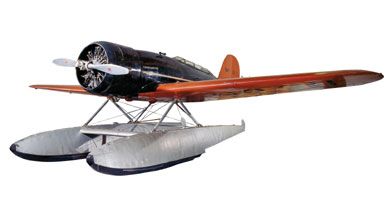Sky Writer
Anne Morrow Lindbergh chronicled the flights made with her celebrated husband
/https://tf-cmsv2-smithsonianmag-media.s3.amazonaws.com/filer/object_NV01e.jpg)
The airplane that Charles Lindbergh flew across the Atlantic on his historic trip from New York to Paris in 1927 was famously named the Spirit of St. Louis. Today, it constitutes one of the most treasured artifacts at the Smithsonian National Air and Space Museum (NASM). But there's another Lindbergh craft there, a 1929 Lockheed 8 Sirius monoplane, that might well be called The Spirit of the Two of Us. In this tandem seat, single-engine plane, America's most celebrated pilot and his new wife, Anne Morrow, flew together on epic journeys that are the aerial equivalent of voyages of discovery by the great 15th- and 16th-century sea captains. In her bestselling North to the Orient, Anne Morrow Lindbergh described the couple's first odyssey, an arduous series of flights covering more than 7,000 miles from the United States over Canada, Alaska and Siberia to China. "Travelers," she wrote, "are always discoverers, especially those who travel by air. There are no signposts in the sky to show a man has passed that way before. There are no channels marked. The flier breaks each second into new uncharted seas." North, and its sequel, Listen! the Wind, vividly convey the romance and revelations of these heroic journeys when flight was still an adventure. The year 2006 marks the centenary of Morrow's birth.
After his triumphant transatlantic flight, Lindbergh made tours of this continent to promote aviation. On a stop in Mexico City, where he was a guest at the U.S. Embassy, Lindbergh met the ambassador's daughter Anne, on Christmas break from Smith College. Her effect on Charles was instant; the gallant knight errant gave the charming young woman a ride in his airplane, and the rest is his—and her—story.
In 1929, Juan Trippe, the aviation entrepreneur who founded Pan American Airlines, hired Lindbergh as a technical consultant (for $10,000 a year and stock options). Trippe's motives, according to author Barnaby Conrad in Pan Am: An Aviation Legend, were mostly for the public relations that came with having America's "Lone Eagle" associated with his fledgling carrier. Lindbergh would be connected with Pan Am for four decades, but his early flights with Anne were as significant as anything he ever would do with the company.
In 1931, Lindbergh announced that he and his wife were taking a flight that he called a vacation, "with no records to be sought." Anne would be copilot, navigator and radio operator. He had already taught her how to fly and had an instructor teach her the ins and outs of radio communication and Morse code. Though Lindbergh claimed the flight had no commercial purpose, in fact it demonstrated the feasibility of what we now call the great-circle route to the Far East. Despite the risks involved in flying into aerial terra incognita, Anne was enthusiastic at the prospect of the quest. Dorothy Cochrane, curator of general aviation at NASM, says that climbing into the Lockheed offered the couple a privacy they rarely enjoyed. "The flights were their way of getting away from the press," she says. "They could not have been happier to get the chance."

Of course, the press was fascinated by the idea of such a couple on such an adventure. The Lindberghs had movie star wattage, yet they were real people doing really extraordinary things. (Some of the marital conversations Anne records in her books have the crisp syncopation of Myrna Loy and William Powell in The Thin Man movies.) Anne, with an indispensable share of duties and still shy with reporters, wrote of her exasperation with the kind of questions she was asked as the couple prepared to climb into the Sirius for the first leg of their trip:
"As I walked out of the building two women ran up to me.
'Oh, Mrs. Lindbergh,' said one, 'the women of America are so anxious to know about your clothes.'
'And I,' said the other, 'want to write a little article about your housekeeping in the ship. Where do you put the lunch boxes?'"
"I felt depressed," she wrote, not surprisingly.
Unlike the awkward-looking Spirit of St. Louis, the low-wing Sirius, designed by John Northrop and Gerard Vultee, has a more aerodynamic shape, a look that would become familiar in later military aircraft. Lindbergh also had asked that there be a double canopy, so that his copilot could have her own opening to the outside air. Initially, he had requested a land-based plane with retractable landing gear—a modern idea at the time—but ended up with floats to take advantage of the many lakes on the northern route.
In the rear cockpit, according to Cochrane, Anne could make the confined space "very comfortable" by removing the plane's second control stick. The space above her controls was open, so the Lindberghs could pass notes back and forth. The pontoons and the fuselage were packed with fuel, supplies, camping gear and emergency equipment.
The durable Sirius was far more than a magic carpet for a daring pair. "These flights were critical to the future of aviation," says Cochrane. Anne Lindbergh felt the enchantment, and divined the importance. "Our route was new;" she wrote, "the air untraveled; the conditions unknown; the stories mythical; the maps, pale, pink, and indefinite, except for a few names, far to the east of our course, to show that someone before us pointed his ship, also, 'North to the Orient.'"
Owen Edwards is executive editor of Edutopia, a magazine about education.
/https://tf-cmsv2-smithsonianmag-media.s3.amazonaws.com/accounts/headshot/Owen-Edwards-240.jpg)
/https://tf-cmsv2-smithsonianmag-media.s3.amazonaws.com/accounts/headshot/Owen-Edwards-240.jpg)